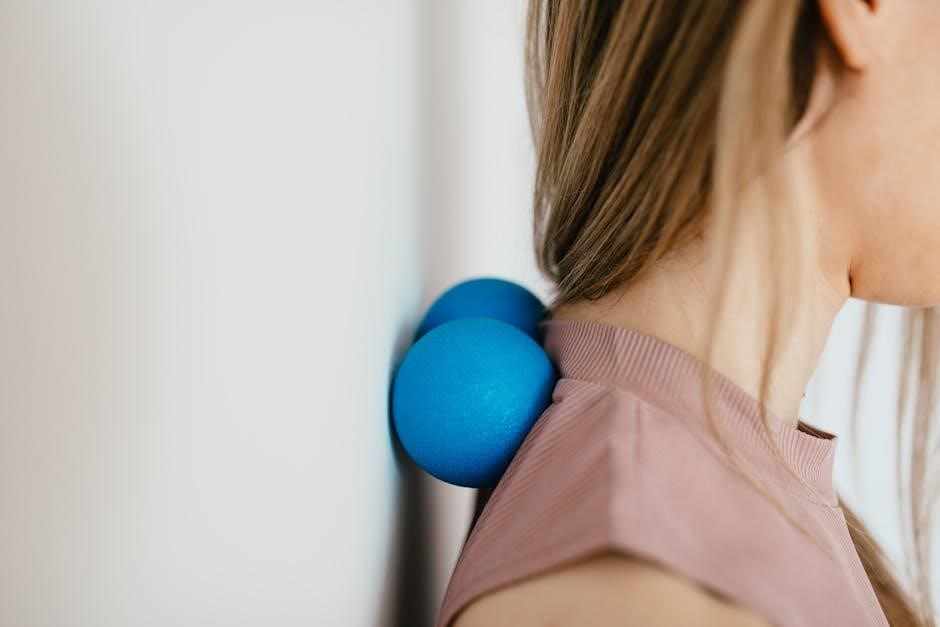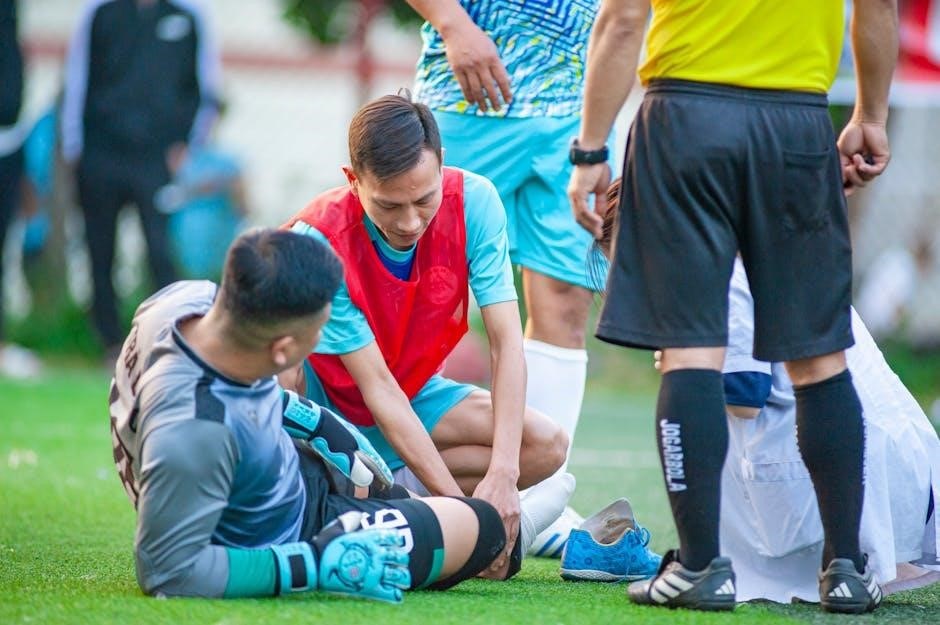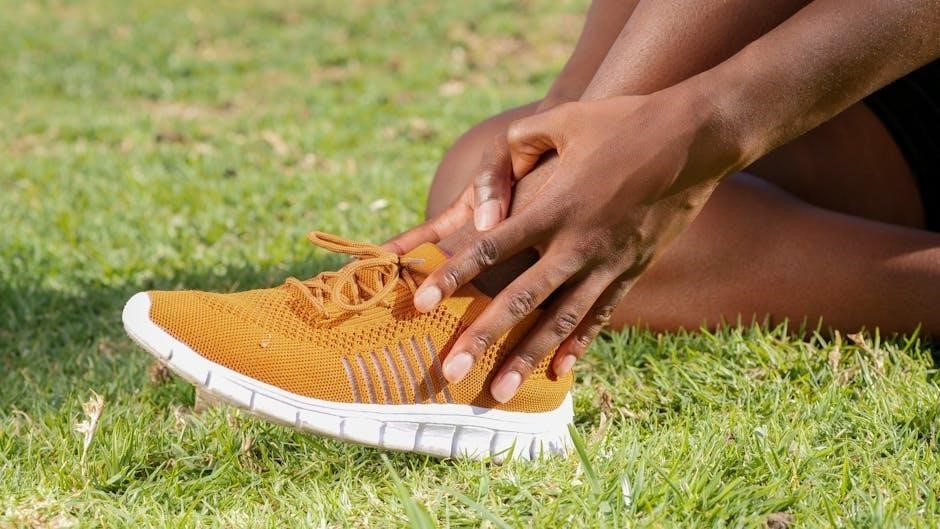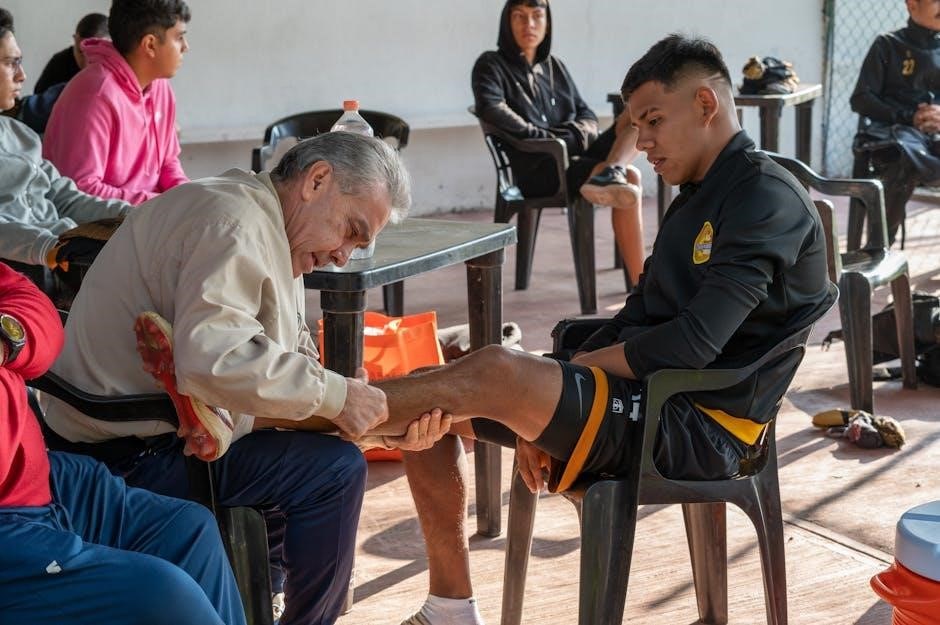
The brachial plexus is a network of nerves controlling arm and shoulder function. Injuries can range from mild to severe, often requiring surgery or therapy.
1.1 What is a Brachial Plexus Injury?
A brachial plexus injury (BPI) occurs when nerves in the shoulder and arm are damaged, often due to trauma, accidents, or childbirth. These nerves control movement and sensation, and damage can range from mild stretching to severe tearing. Symptoms include weakness, numbness, or paralysis of the affected limb. While some injuries heal naturally, others require surgery or therapy. Understanding the injury is crucial for effective rehabilitation and exercise programs to restore function and mobility.
1.2 Importance of Exercises in Rehabilitation
Exercises play a vital role in the rehabilitation of brachial plexus injuries, helping restore mobility, strength, and function. Regular physical therapy can prevent stiffness, improve range of motion, and promote nerve recovery. Tailored exercise programs, often guided by therapists, are essential for maximizing recovery and reducing long-term complications. Consistency in performing these exercises ensures gradual progress, enabling individuals to regain independence and improve their quality of life. Early intervention and adherence to structured routines are key to achieving optimal outcomes.
Types of Brachial Plexus Injury Exercises
Brachial plexus injury exercises include passive range of motion, active-assisted, and active exercises. These therapies aim to improve flexibility, strength, and nerve function, aiding recovery.
2.1 Passive Range of Motion Exercises
Passive range of motion exercises are essential for maintaining joint mobility in patients with limited movement. A therapist gently moves the affected arm through various motions without patient effort. These exercises prevent stiffness, reduce muscle atrophy, and promote circulation. Regular sessions help preserve joint function, preparing the arm for more active therapies as recovery progresses. Consistency is key to achieving optimal results.
2.2 Active-Assisted Exercises
Active-assisted exercises involve the patient using their own muscles with some assistance, such as from a therapist or equipment. These exercises help transition from passive to active movement, improving strength and control. They are particularly useful for patients with partial nerve damage, as they promote muscle activation and joint mobility. Examples include using resistance bands or manual guidance to perform arm movements, fostering independence and functional recovery. Regular practice enhances muscle memory and coordination.
2.3 Active Exercises for Strength and Flexibility
Active exercises focus on strengthening muscles and improving flexibility without assistance. These exercises are typically introduced once a patient has regained some control over their muscles. They include resistance training, such as using light weights or resistance bands, and dynamic stretching to enhance range of motion. Activities like shoulder rotations, arm raises, and grip strengthening are common. These exercises are crucial for restoring functional abilities and preparing the patient for daily activities and more advanced movements. Consistency is key for optimal progress.

Role of Physical Therapy in BPI Rehabilitation
Physical therapy plays a vital role in BPI rehabilitation by improving mobility, strength, and functional independence. Therapists design tailored programs, often involving exercises and manual techniques, to address specific deficits and promote nerve recovery. The goal is to restore as much function and quality of life as possible, working closely with patients to achieve measurable progress.
3.1 How Physical Therapists Design Exercise Programs
Physical therapists design exercise programs for BPI by first assessing the extent of nerve damage and muscle weakness. They create personalized plans focusing on improving range of motion, strength, and functional abilities. Exercises are tailored to the patient’s specific deficits, incorporating passive, active-assisted, and active movements. Therapists also consider the patient’s goals and progress, adjusting the program as needed to optimize recovery and prevent complications like contractures or stiffness. Regular monitoring ensures the exercises remain effective and safe.
3.2 Monitoring Progress and Adjusting Exercises
Physical therapists regularly monitor patients’ progress through assessments and feedback. They evaluate improvements in strength, range of motion, and functional abilities. Adjustments to exercises are made based on individual recovery, ensuring optimal outcomes. Therapists may incorporate new techniques or increase exercise intensity as patients heal. Regular reassessments help prevent plateaus and address any emerging issues, ensuring the program remains tailored to the patient’s needs and promotes steady recovery without overexertion. This adaptive approach is crucial for effective rehabilitation.

Exercises Based on Injury Severity
Exercises are tailored to injury severity, with mild cases focusing on gentle mobilization and severe cases requiring advanced strengthening techniques to restore function and mobility.
4.1 Mild Injuries: Gentle Stretching and Mobilization
For mild brachial plexus injuries, gentle stretching and mobilization exercises are essential to maintain flexibility and prevent stiffness. These exercises focus on improving range of motion without causing further strain. Techniques may include passive range of motion exercises, where a therapist assists the patient, and active-assisted exercises using tools like resistance bands. Regular, gentle mobilization helps restore natural movement and reduces the risk of contractures. Consistency is key to gradual recovery and strength regain.
4.2 Severe Injuries: Advanced Strengthening Techniques
For severe brachial plexus injuries, advanced strengthening techniques are crucial to restore lost function. These may include resistance training, progressive resistance exercises, and electrical stimulation to activate weak muscles. Surgery is often necessary, followed by intensive physical therapy. Therapists design tailored programs to rebuild strength and improve mobility. Functional training is also incorporated to help patients regain control over daily activities. Consistency and progression in these exercises are vital for achieving meaningful recovery and independence.
When to Start Exercises After Injury
Exercise should begin immediately after injury, focusing on gentle movements to prevent stiffness. Timing varies based on severity, with severe cases requiring post-surgical rehabilitation protocols.
5.1 Immediate Post-Injury Care and Exercise Timing
Immediate post-injury care involves stabilizing the affected area to prevent further damage. Gentle exercises can start shortly after injury to maintain mobility and prevent stiffness. The timing of exercises depends on the severity of the injury and whether surgery is required. For mild cases, early mobilization is crucial, while severe injuries may necessitate a delayed approach, focusing on post-surgical recovery before active exercises begin.
5.2 Avoiding Overexertion in the Early Stages
Avoiding overexertion is critical in the early stages of brachial plexus injury recovery. Overexertion can worsen nerve damage and delay healing. Patients should focus on gentle, controlled movements and avoid heavy lifting or repetitive strain. Monitoring fatigue and pain levels is essential to prevent overuse. Early exercises should prioritize mobility without causing discomfort, ensuring a balance between activity and rest to support nerve repair and overall recovery.

Role of Occupational Therapy in Recovery
Occupational therapy focuses on improving functional abilities and daily living skills. It includes customized splinting, adaptive equipment, and tailored exercises to enhance independence and mobility in patients.
6.1 Customized Splinting and Adaptive Equipment
Customized splinting and adaptive equipment play a crucial role in brachial plexus injury recovery. Splints stabilize joints, preventing contractures and promoting proper alignment. Adaptive tools, such as ergonomic grips or reachers, assist with daily tasks, enhancing independence. These devices are tailored to individual needs, ensuring optimal support and functionality during rehabilitation. They help patients perform exercises effectively and maintain mobility while recovering.
6.2 Functional Activities for Daily Living
Functional activities focus on improving independence in daily tasks, such as dressing, cooking, and grooming. Occupational therapists design tailored exercises to enhance coordination and strength, enabling patients to perform everyday actions. These activities are integrated into rehabilitation programs to restore practical skills, promoting confidence and self-reliance. By practicing these tasks, individuals can gradually regain the ability to manage their daily lives effectively during recovery from brachial plexus injuries.

Preventing Complications Through Exercise
Regular exercises help prevent complications like contractures and stiffness by maintaining joint mobility and muscle flexibility. This reduces the risk of long-term physical limitations.
7.1 Avoiding Contractures and Stiffness
Contractures and stiffness are common complications of brachial plexus injuries, arising from prolonged immobility. Gentle stretching exercises, such as shoulder rotations and elbow flexions, can help maintain joint mobility. Regular passive range of motion exercises, especially when performed consistently, prevent the shortening of muscles and tendons, reducing the risk of permanent deformities. Early intervention is crucial to ensure full recovery and functional use of the affected limb.
7.2 Managing Pain During Rehabilitation
Managing pain during brachial plexus injury rehabilitation is crucial for effective recovery. Techniques such as ice therapy, massage, and anti-inflammatory medications can alleviate discomfort. Gentle exercises, like passive stretching, help reduce stiffness without exacerbating pain. Pain management plans are often tailored to individual needs, ensuring patients can perform exercises consistently. Addressing pain early prevents it from becoming a barrier to rehabilitation progress and promotes a smoother recovery process.
Duration and Frequency of Exercise Sessions
Exercise sessions for brachial plexus injuries typically last 30-60 minutes, performed 3-5 times weekly. Consistency is key to gradual improvement and preventing stagnation in recovery.
8.1 Recommended Daily Exercise Routine
A daily routine should include 30-45 minutes of targeted exercises, focusing on passive range of motion, active-assisted movements, and gentle strengthening. Start with low-intensity activities, gradually increasing as tolerance improves. Incorporate exercises like shoulder rotations, elbow bends, and wrist extensions to maintain flexibility and strength. Breathing techniques and relaxation exercises can also be included to manage stress and promote recovery. Consistency is crucial to avoid muscle atrophy and improve functional outcomes over time.
8.2 Progressing Exercise Intensity Over Time
Exercise intensity should gradually increase as strength and mobility improve. Begin with gentle, low-resistance movements, then transition to moderate resistance using light weights or resistance bands. Active-assisted exercises can evolve into full active movements as control and strength enhance. Incorporate functional activities to mimic daily tasks, ensuring exercises remain challenging yet safe. Regular assessments by therapists guide progression, preventing plateaus and optimizing recovery outcomes over time.
Effective rehabilitation combines passive and active exercises, gradually increasing intensity to restore strength and mobility. Consistency and personalized therapy plans are crucial for optimal recovery outcomes.
9.1 Summary of Key Exercise Strategies
Effective rehabilitation for brachial plexus injuries involves a combination of passive and active exercises, tailored to the severity of the injury. Passive range-of-motion exercises help maintain flexibility, while active-assisted and active exercises strengthen muscles. Physical and occupational therapy play crucial roles, with exercises progressing gradually to restore function. Consistency and adherence to personalized plans are essential for optimal recovery. The goal is to improve mobility, strength, and daily functionality, ensuring the best possible outcomes for patients.
9.2 Importance of Consistency in Rehabilitation
Consistency in rehabilitation is vital for effective recovery from brachial plexus injuries. Regular and disciplined exercise routines, as outlined in rehabilitation guides, ensure gradual nerve repair and muscle strengthening. Without consistent effort, progress may stagnate, leading to prolonged recovery or complications like muscle atrophy. A structured routine, combined with professional guidance from physical and occupational therapists, helps patients achieve meaningful improvements in mobility and function, ultimately enhancing their quality of life and independence.
Additional Resources
- Downloadable PDF guides provide detailed exercise routines for BPI recovery.
- Online forums offer support and share recovery experiences.
- Hospital websites, like Stanmore, share specialized therapy resources.
10.1 Recommended PDF Guides for BPI Exercises
Trusted sources like medical institutions and rehabilitation centers offer comprehensive PDF guides for BPI exercises. These guides provide detailed routines, including stretching techniques and strengthening exercises. They often include visual aids and step-by-step instructions tailored to different injury severities. Many PDFs emphasize the importance of consistency and offer practical advice for creating a home workout plan. Additionally, some guides focus on advanced techniques for severe injuries, ensuring a holistic approach to recovery.
10.2 Online Communities and Support Groups
Online communities and forums dedicated to brachial plexus injuries offer valuable support and resources. Patients and caregivers can share experiences, ask questions, and access exercise tips. Many groups provide links to downloadable PDF guides and video tutorials. Professional organizations also host live webinars and Q&A sessions with experts. These platforms foster connection and provide emotional support, helping individuals stay motivated during their recovery journey.